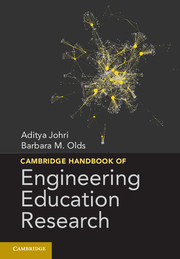Book contents
- Frontmatter
- Dedication
- Contents
- Editors
- Contributors
- Foreword
- Acknowledgments
- Introduction
- Chapter 1 Chronological and Ontological Development of Engineering Education as a Field of Scientific Inquiry
- Part 1 Engineering Thinking and Knowing
- Part 2 Engineering Learning Mechanisms and Approaches
- Part 3 Pathways into Diversity and Inclusiveness
- Part 4 Engineering Education and Institutional Practices
- Part 5 Research Methods and Assessment
- Part 6 Cross-Cutting Issues and Perspectives
- Chapter 30 Engineering Communication
- Chapter 31 Use of Information Technology in Engineering Education
- Chapter 32 Global and International Issues in Engineering Education
- Chapter 33 Engineering Ethics
- Chapter 34 The Normative Contents of Engineering Formation
- Chapter 35 Interdisciplinarity in Engineering Research and Learning
- Conclusion Engineering at the Crossroads
- Index
- References
Chapter 30 - Engineering Communication
Published online by Cambridge University Press: 05 February 2015
- Frontmatter
- Dedication
- Contents
- Editors
- Contributors
- Foreword
- Acknowledgments
- Introduction
- Chapter 1 Chronological and Ontological Development of Engineering Education as a Field of Scientific Inquiry
- Part 1 Engineering Thinking and Knowing
- Part 2 Engineering Learning Mechanisms and Approaches
- Part 3 Pathways into Diversity and Inclusiveness
- Part 4 Engineering Education and Institutional Practices
- Part 5 Research Methods and Assessment
- Part 6 Cross-Cutting Issues and Perspectives
- Chapter 30 Engineering Communication
- Chapter 31 Use of Information Technology in Engineering Education
- Chapter 32 Global and International Issues in Engineering Education
- Chapter 33 Engineering Ethics
- Chapter 34 The Normative Contents of Engineering Formation
- Chapter 35 Interdisciplinarity in Engineering Research and Learning
- Conclusion Engineering at the Crossroads
- Index
- References
Summary
Communication has long been considered a core professional skill and one clearly central to global engineering practice. In Sales’ (2006) survey of U.K. engineers, more than 50% of her respondents spent more than 40% of their time on writing. In Australia, surveys by Male, Bush, and Chapman consistently identify communication as a critical (and deficient) quality in engineering graduates (Male, Bush, & Chapman, 2010, 2011). Surveys by Tenopir and King (2004) and Covington, Barksdale, Egan-Warren, Larsen, and Trunzo (2007) found that U.S. engineers spent upwards of 30% of their time writing and speaking, while Kreth's (2000) survey of U.S. graduates indicated that new engineers spent, on average, 38% of their time writing. In non–English-speaking regions and countries, the prevalence of English for Special Purposes (ESP), English for Academic Purposes (EAP), and second language (L2, sometimes referred to as English as a Foreign Language, or EFL) instruction for engineers attests to the ongoing need for communication competency in English as well as in engineers’ native languages (e.g., Cismas, 2010; Orr et al., 1995).
Beyond its ubiquity in practice, engineering communication can profoundly affect both the development and the impact of technology. Most dramatically, as studies of the U.S. space shuttle Challenger explosion and the near-meltdown of the Three Mile Island nuclear facility demonstrate, failures in engineering communication are often central factors in engineering disasters (e.g., Dombrowski, 1992; Herndl, Fennell, & Miller, 1991; Winsor, 1988). Even a failure to appropriately identify units of measure can cost millions, as in the case of the NASA orbiter developed by Lockheed Martin (Isbell, Hardin, & Underwood, 1999). Effective communication in engineering environments, such cases remind us, can have exceptionally high stakes.
- Type
- Chapter
- Information
- Cambridge Handbook of Engineering Education Research , pp. 601 - 632Publisher: Cambridge University PressPrint publication year: 2014
References
- 27
- Cited by

